Veneers vs Bonding in NYC: Which One Is Right for You?
Veneers and bonding are common practices for people familiar with cosmetic dentistry. To anyone new to this field who wants to restore their smile, the veneers vs bonding decision is confusing. At 65 Broadway Dental, we know the differences and how to help you make the best decision.
If you’ve made your first cosmetic appointment, here’s what to expect at your first cosmetic dentistry appointment.
What are Veneers?
Have you ever seen a perfect smile, without gaps or discoloration? Then you’ve already seen the after effects of veneers!
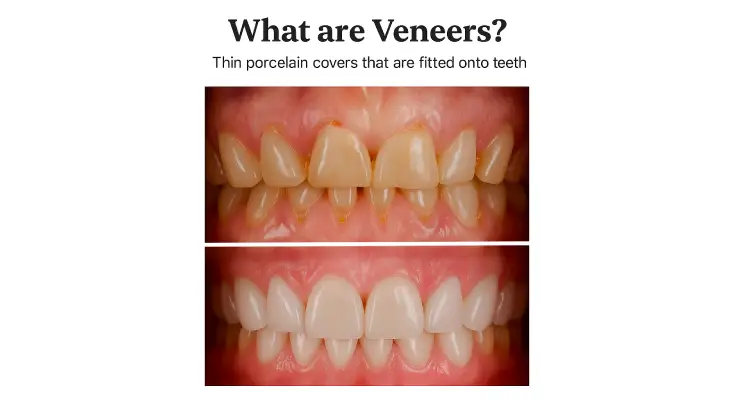
Porcelain veneers are thin covers that are fixed onto the front surface of teeth. These covers are custom-made to fit well and are attached with a dental cement. This process helps to restore the appearance of teeth, hiding gaps, stains, and even chips.
This procedure is for people seeking a long-lasting smile makeover.
When to Get Veneers? (Ideal Candidates for Veneers)
Comparing veneers vs bonding correctly requires an understanding of who benefits most from them. See the ideal candidates for veneers to see if you are one of them:
- People who want a completely new smile
- Severe staining that teeth whitening cannot fix
- Crooked and uneven teeth leading to gaps
- Teeth with signs of wear and tear
- Teeth that are small or too short
What is the Procedure to Get Veneers?
Getting veneers is more complicated as it requires more than one visit. Here’s what the process for both visits entails.
First Doctor Visit - Step 1: Initial Examination
The first visit will require your dentist to check the health of your teeth. It may require them to take some X-rays to discover if the teeth are healthy enough for the procedure.
Step 2: Removing Tooth Enamel
Once all tests and measurements are taken, your dentists will start preparing your teeth. It will require tooth numbing before they can begin removing tooth enamel. Removing this enamel is necessary to house the new porcelain veneers.
Step 3: Selecting the Veneers
Once the teeth are prepared, the dentist can start checking the color of the veneers to select. A matching shade to your original teeth is ideal; get a shade lighter for front teeth. A dental impression will also be taken to measure the size of your teeth.
Step 4: Custom Veneers & Temporary Veneers
The dental impression is sent to the dental lab to ensure your veneers are custom-made. Making these veneers can take up to 2 weeks.
In the meantime, your dentist will provide a set of temporary veneers to protect your teeth. Some dentists design these temporary veneers based on a tailored smile design. The smile design allows patients to see if they like their new smile before it’s permanent.
Second Doctor Visit - Step 1: Temporary Veneer Removal
Your dentist will ask you to come in when your new veneers are ready. You’ll need to take off the temporary veneers in a process that requires local anesthesia.
Step 2: Try the New Veneers
After the temporary veneers are out, your dentist puts in the new veneers. This will be to check the fit, and you will finally get to see them!
Step 3: Adjustments
This trial session gives patients or dentists the chance to raise any appearance or fitting concerns. Changes will be necessary to ensure the perfect fit and one that’s comfortable.
Step 4: Permanent Fitting
After completing changes, the patient and dentist are satisfied and ready for permanent bonding. The veneers are attached to the teeth using a special cement, and your new smile is ready!
What is Bonding?
Bonding, also known as composite bonding, is a process that reshapes or resculpts teeth. A material (resin) that matches your tooth color is placed onto them and shaped. Afterwards, your dentist polishes it to look more natural and align with the surrounding teeth.
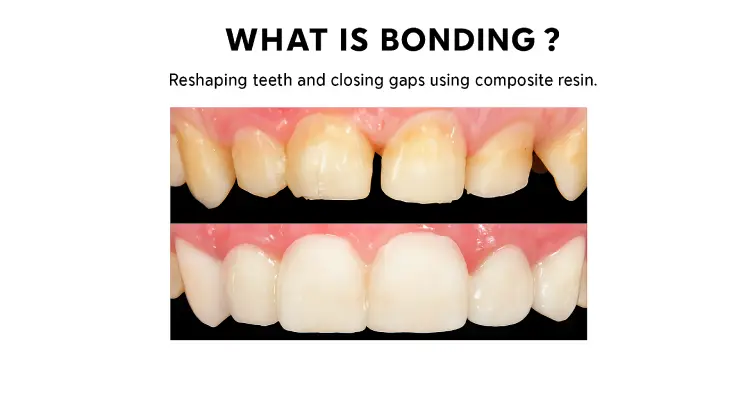
The bonding process is a quick and cost-efficient option to fix your teeth’s appearance. It’s a fast and pain-free option to restore your smile.
At the end, you can’t separate the resin material from your real teeth by appearance.
When to do Bonding? (Ideal Candidates for Bonding)
Selecting bonding is only suitable if you are an ideal candidate for this procedure. You qualify if you meet one or more of these needs:
- Your teeth have a few chips or cracks
- There are spaces between teeth that you want to close or reduce
- You want to make your teeth longer
- Whitening is no longer able to hide discoloration
- Many teeth aren’t the right size or shape
What is the Procedure for Bonding?
Choosing bonding leads to a relatively straightforward process that is stress-free and simple.
Step 1: Initial Assessments
The dentist uses oral exams to check which teeth require bonding and identify the main issues. This preliminary check helps your dentists measure the extent of tooth damage.
Step 2: Resin Selection
The next step will be to select the right resin. The ideal composite resin would match your tooth color.
Step 3: Preparing Teeth for Application
Before applying any material to the teeth, even the resin, they need to be prepared. Roughening the surface provides more surface area. This additional surface area is beneficial for making the composite resin attach to teeth.
Step 4: Applying the Conditioning Liquid
Applying a conditioning liquid to the teeth helps the resin attach strongly to the teeth. It ensures years go by without any issues, such as loosening.
Step 5: Resin Application
After applying the composite resin, dentists use a special light to harden the material. When the composite resin is hard enough, dentists will shape and polish it.
Comparison Chart for Veneers vs Bonding
| Feature | Veneer | Bonding |
|---|---|---|
| Purpose | Complete smile makeover | Fixes minor issues like cracks & chips |
| Appearance | Looks natural and won’t stain | Appear natural, but can stain |
| Cost | $900 to $2,500 per tooth | $150 to $600 per tooth |
| Treatment Type | Scrapes teeth and fixes shells on the front | Application of resin and reshaping of teeth |
| Duration of Effects | Lasts 10 to 15+ years | Lasts 3 to 7 years |
| Treatment Duration | Needs 2 or 3 seatings | Requires one seating |
| Materials Used | Thin porcelain coverings | Tooth-colored resin |
| Damage to Teeth | Requires damage to enamel | Doesn’t damage enamel |
Veneers vs Bonding: Advantages
| Veneers | Bonding |
|---|---|
| Look natural | Matches the color of your teeth |
| Lasts 10 to 15 years or more | Lasts 3 to 7 years before needing replacement |
| Customized size to match your smile | Resin is applied to and custom-shaped |
| Ideal for major changes | Ideal for minor changes |
| Resistant to stains and discoloration | Less expensive than veneers |
| Highly customizable dental solution | Quick treatment process |
Veneers vs Bonding: Disadvantages
| Veneers | Bonding |
|---|---|
| Requires tooth enamel to be scraped off | Can only cover minor tooth issues |
| Relatively high costs | Bonding resin can be stained or discolored |
| Requires multiple sessions to complete | Doesn’t last as long as veneers |
| Stronger than bonding, but can still break | Bonding materials are prone to breakage |
| Some patients complain of sensitivity in the gums and teeth | The results are not that significant |
What Factors Influence the Veneers vs Bonding Decision?
Selecting the right procedure requires you to make a decision based on the following factors:

1. Personal Preferences
A leading factor to consider is the reason behind the procedure. List the issues you wish to solve and the order of priority. Stating your expectations helps to establish what is most suitable for your needs.

2. Procedure Cost
If you’re looking for an affordable fix, bonding ranges between $150 and $600 per tooth. If you’ve a larger budget, veneers cost $900 to $2,500 per tooth. At first, veneers seem costly, but they’re an investment that lasts longer.

3. Dentist Experience
Experienced dentists are best when considering cosmetic procedures to enhance your smile. They have more experience in these procedures and have successfully done each one several times. Such dentists may have higher prices, but their work is reliable.

4. Treatment Process
Both procedures follow a different treatment process. Patients need to be aware of these changes as they require distinct care and maintenance.

5. Available Time
The time you have to do the treatment also influences the final decision. If you’re in a rush, the faster solution is bonding. However, if you have more time for a two-part treatment plan, choose veneers.
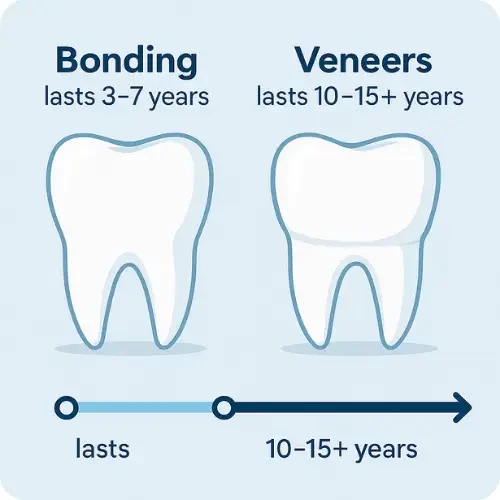
6. How Long Results Last
The duration of treatment effects is a consideration when debating veneers vs bonding. The one that lasts longer may be suitable for people seeking lasting effects. Anyone looking for a quick solution for an event won’t care too much about duration.
What are the Care Requirements for Veneers & Bonding?
The care requirements for veneers and bonding are the same; this is what they entail.
- Commit to improving oral hygiene by brushing twice and flossing once a day.
- Visit a dentist regularly and immediately if you’ve damaged your veneers or bonding.
- Stop biting on hard objects, and avoid hard and sticky foods.
- Start wearing a nightguard if you grind your teeth at night.
- Check for signs of damage and don’t wait to repair them.
Conclusion
Deciding between veneers and bonding isn’t just about maintaining your appearance. Procedures like these are necessary to find your confidence, so make an impactful choice.
65 Broadway Dental restores your smile, allowing you to confidently show your teeth, regardless of which one you choose.
FAQs
1. What lasts longer, veneers or bonding?
Based on a large pool of data, veneers are much longer-lasting than bonding. They can even last more than 15 years with the right care.
2. Does dental bonding look natural?
Yes, dental bonding looks natural because your dentist customizes the resin to match the others.
3. Can teeth rot under bonding?
Bonding only protects the surface of the teeth, so yes, teeth under bonding can rot.
4. Can bonding be whitened?
No, you cannot whiten bonding because the resin doesn’t react to the treatment like enamel does.
5. What is a cheaper alternative to veneers?
You can clean and fix your teeth through bonding, an affordable alternative to veneers.
6. How much does teeth bonding cost in NYC?
Teeth bonding costs in New York City can vary based on various factors. On average, NYC teeth bonding costs will range from $150 to $600 per tooth.
7. Do veneers damage real teeth?
It does since the tooth enamel must be scraped to make space to attach the veneers.

Dr. Alexander Heifitz (Author)
Dr. Alexander Heifitz is the founder of 65 Broadway Dental in NYC, where he combines advanced dental expertise with a patient-first approach. He specializes in cosmetic and restorative treatments such as dental implants, veneers, Invisalign, and smile makeovers, helping New Yorkers achieve both oral health and confidence.
Booking An Appointment
Looking for a reliable dentist in Downtown NYC? Whether you need a routine cleaning, urgent care, or a full smile transformation — we’ve got you covered. We accept most PPO insurance plans and offer flexible scheduling.
+1 (212) 430-3888
Call for appointment
Walk-ins Welcome / Same-Day Appointments Available

Related Blogs
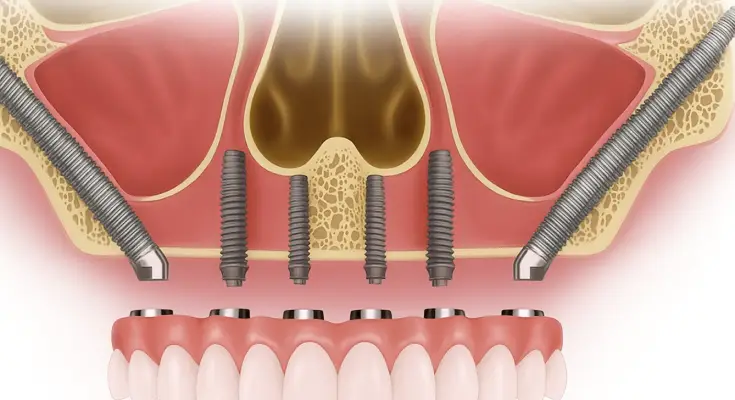
Zygomatic Dental Implants: Are They Right for You in NYC?
Discover zygomatic dental implants in NYC. Learn who qualifies, key benefits, and how this advanced solution restores smiles when traditional implants aren’t possible.
Read More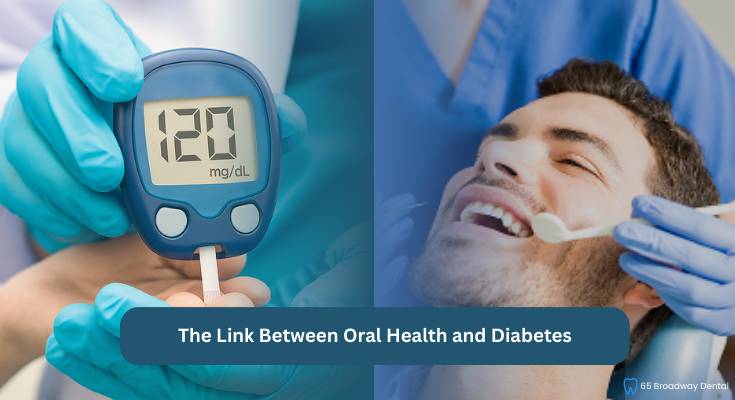
The Link Between Oral Health and Diabetes
Oral Health and Diabetes are closely linked. Poor diabetes control can cause gum disease, infections, and slow healing, impacting overall health.
Read More